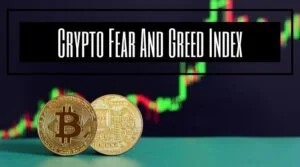What is the Crypto fear and greed index? To get an idea of how the notion of such an index came to be, we have to look at a similar project started by CNN. The cable news giant reports a daily measurement of investment market conditions based on a series of factors used to determine the “mood of the market”.
 Take a quick tour of any cryptocurrency website, Bitcoin exchange, or crypto blog and you’ll read the same type of blurbs–virtual currency investors are driven by two basic emotions. Emotional investing is never a good idea but many in the crypto space give into these temptations for better or worse.
Take a quick tour of any cryptocurrency website, Bitcoin exchange, or crypto blog and you’ll read the same type of blurbs–virtual currency investors are driven by two basic emotions. Emotional investing is never a good idea but many in the crypto space give into these temptations for better or worse.
The two market-driving emotions are fear and greed (no surprise, given the name of this article) and those two factors are essentially the opposite of the headspace most experienced financial planners tell you to get into.
What is that headspace? One that is not ruled by emotion but by pragmatic decision-making based on the available facts.
What causes a rise in fear and greed? There are multiple indicators that the CNN Index uses to measure the emotional tone on the virtual “trading floor”. These factors (at lease where the CNN project is concerned) include the strength of stock prices in a given day, the amount of volatility that may be present in the markets on a given day, the demand for “safe haven” investments such as Treasuries, the volume of put and calls, and more.

Fear, Greed, And Investing
CNN’s Fear and Greed Index uses these factors to determine a daily mood based on a set of percentage points assigned to each factor. The mood of the market at press time indicated that at that moment when the index was finalized for the day, the overall emotion of the market was “Greed”.
The index can be useful to investors–are you betting against the market? Seeing “Greed” as the market mood could influence a savvy investor’s choices depending on strategy. The higher the amount of fear, the more profit-taking an investor could potentially do. The higher the amount of greed and an investor could find themselves competing hard to buy hot stocks or other investments.
When does the trading floor become a seller’s market and when does it become a buyer’s market? That’s an area the Fear and Greed Index is meant to help you decide.
The Crypto Fear and Greed Index
Alternative.me is the company responsible for the Crypto Fear and Greed Index. The name is something of a misnomer as this index is marketed as being for Bitcoin and “other large cryptocurrencies” though the basic index as presented on the company’s website at press time was for Bitcoin only.
Similar to the CNN index, the Crypto Fear and Greed Index is comprised of multiple factors gathered same-day to get a sense of the “mood” of the cryptocurrency marketplace. Those factors include but are not limited to:
- Google Trends
- Market volatility
- Market volume
- Market momentum
- Social media buzz
- Marketplace dominance
How The Crypto Fear And Greed Index Works
Low numbers indicate more fear–higher numbers indicate more greed. These numbers are applied specifically to Bitcoin’s presence in the market. Fear means fewer people purchasing Bitcoin. Greed means more people are buying.
The numbers are on a specific scale from the lowest (zero to 24) being “extreme fear” and the highest numbers (75-100) being “extreme greed”. There are also some nuances among these number ranges. For example:
- 25-49: this is when the market is not panicking, but there is no rally in the immediate future.
- 50-74: a “greed” range that tends to indicate big sell-offs are not forthcoming.
Legacy Data Of The Fear And Greed Index
Smart investors do not pay attention solely to the current day, week, or month of trading habits around a certain stock, commodity, or digital currency. Smart investors look at the long tail of their investments–how does the stock do over time?
For example, if you are interested in buying Starbucks stock, you would want to look at the 52-week average of the sale price of shares of Starbucks to determine what might be a reasonable buy-in point and a smart stop-loss point.
If you don’t do this and you hear talk of the time when Starbucks stock was offered for $17 (it’s well above $110 per share at press time) you might think that prices in the current marketplace for Starbucks stock is unreasonable.
That is, until you learn that the $17 per share price was from the initial public offering back in the 1970s. So what’s a reasonable price for Starbucks today? That depends a lot on what’s happened in the previous 52 weeks. You’ll want to review that data to see what the long-haul performance of the stock is.
For the Crypto Fear And Greed Index official site there is a graph that shows the long-term performance of Bitcoin including data ranging from seven days, a full year, and “max” which reflects data from 2018 to 2021. This performance data is important for some investors who follow trends to bet on or against in the crypto space.
Not Investment Advice
Neither this article nor the Crypto Fear and Greed Index should be interpreted as advice on investing, investment opportunities, etc. The information presented here and by the Index is meant for informational purposes only and should not be interpreted as a call to action, a recommendation, or an endorsement of Bitcoin or any other financial instrument, investment, or option.
Joe Wallace has covered real estate and financial topics, including crypto and NFTs since 1995. His work has appeared on Veteran.com, The Pentagon Channel, ABC and many print and online publications. Joe is a 13-year veteran of the United States Air Force and a former reporter for Air Force Television News.

